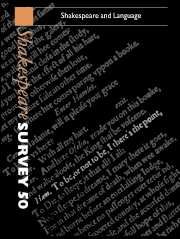Book contents
- Frontmatter
- Shakespeare’s Language and the Language of Shakespeare’s Time
- ‘I’ll plague thee for that word’: Language, Performance, and Communicable Disease
- The Language of the Spectator
- Marlowe’s Edward II: Penetrating Language in Shakespeare’s Richard II
- Hamlet’s Ear
- Secrecy and Gossip in Twelfth Night
- Shakespeare Rewriting Ovid: Olivia’s Interview with Viola and the Narcissus Myth
- ‘Voice Potential’: Language and Symbolic Capital in Othello
- Household Words: Macbeth and the Failure of Spectacle
- Erring and Straying Like Lost Sheep: The Winter’s Tale and The Comedy of Errors
- The ‘Shakespearian Gap’ in French
- Reading the Early Modern Text
- Shakespeare and the Metamorphosis of the Pentameter
- Rereading Illustrations of the English Stage
- Nietzsche’s Hamlet
- ‘Strange and woonderfull syghts’: The Tempest and the Discourses of Monstrosity
- Shakespeare Performances in England, 1996
- Professional Shakespeare Productions in the British Isles, January–December 1995
- 1 Critical Studies
- 2 Shakespeare’s Life, Times, and Stage
- 3 Editions and Textual Studies
- Books Received
- Index
Shakespeare and the Metamorphosis of the Pentameter
Published online by Cambridge University Press: 28 March 2007
- Frontmatter
- Shakespeare’s Language and the Language of Shakespeare’s Time
- ‘I’ll plague thee for that word’: Language, Performance, and Communicable Disease
- The Language of the Spectator
- Marlowe’s Edward II: Penetrating Language in Shakespeare’s Richard II
- Hamlet’s Ear
- Secrecy and Gossip in Twelfth Night
- Shakespeare Rewriting Ovid: Olivia’s Interview with Viola and the Narcissus Myth
- ‘Voice Potential’: Language and Symbolic Capital in Othello
- Household Words: Macbeth and the Failure of Spectacle
- Erring and Straying Like Lost Sheep: The Winter’s Tale and The Comedy of Errors
- The ‘Shakespearian Gap’ in French
- Reading the Early Modern Text
- Shakespeare and the Metamorphosis of the Pentameter
- Rereading Illustrations of the English Stage
- Nietzsche’s Hamlet
- ‘Strange and woonderfull syghts’: The Tempest and the Discourses of Monstrosity
- Shakespeare Performances in England, 1996
- Professional Shakespeare Productions in the British Isles, January–December 1995
- 1 Critical Studies
- 2 Shakespeare’s Life, Times, and Stage
- 3 Editions and Textual Studies
- Books Received
- Index
Summary
Many years ago I attended a conference at Providence, RI, at which the main speaker was O. B. Hardison Jr, then the Director of the Folger Shakespeare Library. He demonstrated that in the sixteenth century all the critics agreed that the iambic pentameter was the most colloquial form of verse, ‘nearest prose’. (I had inadvertently, or subconsciously, echoed Dryden’s phrase that described the rhymed couplets he had used in Religio Laici). Although Hardison admitted that dramatic verse was a special case, he gave the impression, which he afterwards modified, that the actors ought to speak the verse as colloquially as possible. Some of the old actors, when I first came to the theatre, declaimed the most prosaic passages as pompously as they knew how. But there are verse passages that are not at all prosaic. I doubt whether any good actor, remembering Marlowe’s mighty line and the mightier line of Shakespeare’s tragedies, could be persuaded to be what Hamlet called ‘tame’.
Some directors, indeed, have done their best to make the actor speak the lines as prose. In a production of Antony and Cleopatra a few years ago, my brother, who appeared mainly on television, was shocked to discover that the whole text had been re-typed as prose. Another relation of mine, Miriam Adams, playing the Woman Killed with Kindness, with Robert Donat as her lover, told me that the kind husband was played by a successful West End actor, who had never before ventured to perform in an Elizabethan play.
- Type
- Chapter
- Information
- Shakespeare Survey , pp. 147 - 150Publisher: Cambridge University PressPrint publication year: 1997



